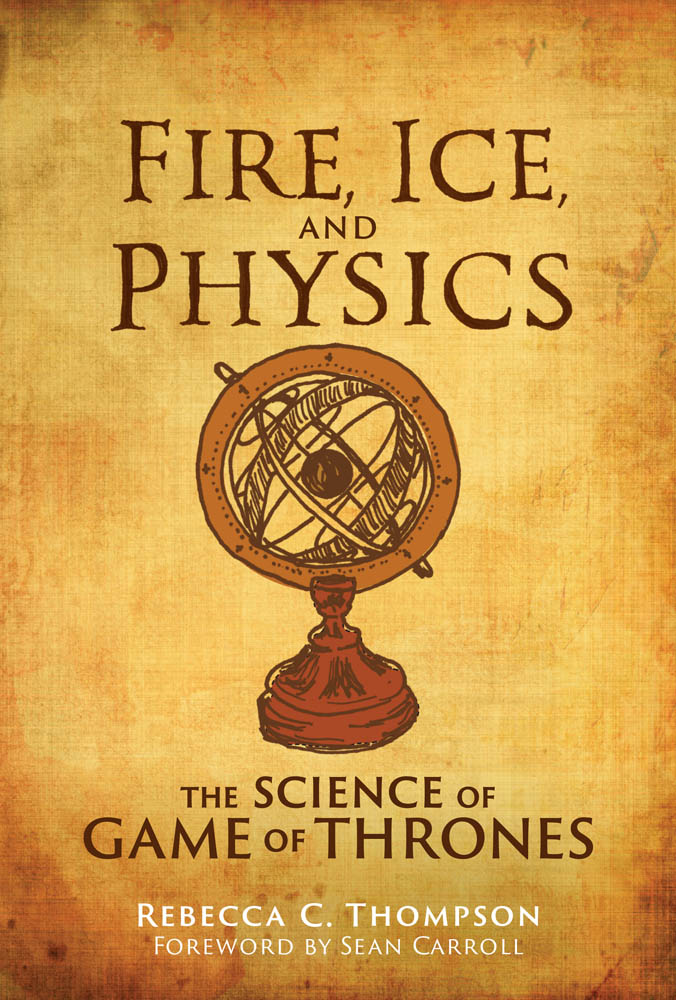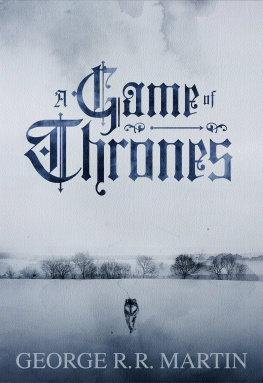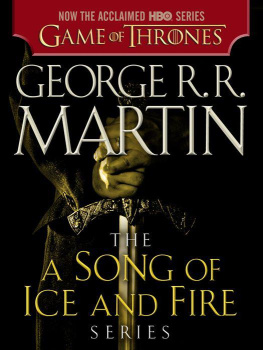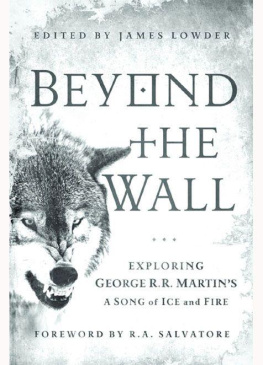
Fire, Ice, and Physics
Fire, Ice, and Physics
The Science of Game of Thrones
Rebecca C. Thompson
Foreword by Sean Carroll
The MIT Press
Cambridge, Massachusetts
London, England
2019 Rebecca C. Thompson
All rights reserved. No part of this book may be reproduced in any form by any electronic or mechanical means (including photocopying, recording, or information storage and retrieval) without permission in writing from the publisher.
Library of Congress Cataloging-in-Publication Data
Names: Thompson, Rebecca C., author.
Title: Fire, ice, and physics : the science of Game of Thrones / Rebecca C. Thompson ; foreword by Sean Carroll.
Description: Cambridge, MA : The MIT Press, [2019] | Includes bibliographical references and index.
Identifiers: LCCN 2019001209 | ISBN 9780262043076 (hardcover : alk. paper)
Subjects: LCSH: Science--Popular works. | Science in popular culture. | Game of Thrones (Television program)
Classification: LCC Q162 .T42945 2019 | DDC 500--dc23
LC record available at https://lccn.loc.gov/2019001209
10 9 8 7 6 5 4 3 2 1
ISBN: 978-0-262-04282-6
Retail e-ISBN: 978-0-262-35449-3
Library e-ISBN: 978-0-262-35448-6
MITP e-ISBN: 978-0-262-35447-9
d_r0
To
P.W.H., E.J.E., and R.I.M.
Next time I have an idea like that, punch me in the face.
Tyrion Lannister
Contents
What Exactly Are Seasons?
Why Does Earth Have Seasons?
Very Elliptical Orbit
Moving Axis
Milankovitch Cycles
Two Suns?
So, What about Westeros?
What Is Ice and How Does It Work?
The Amazing Pykrete
Ice on a Large Scale Is Basically Ketchup
The Great Wall of Westeros versus The Westernport Wall
Body Temperature Regulation
When Your Body Just Cant Take It
Animal Fur (Evolution Is Amazing)
Keeping Humans Warm
Does Jon Snow Need a Hat?
What Is a Zombie, and Do Wights and White Walkers Count?
Neurology and Biology of Zombies
Zombie/Wight Rot
Zombie Neurology: Whats Going on in Their Heads?
Zombie Statistics and a Survival Plan: Can Westeros Get Out Alive?
Bonus: Zombie Dragons
Hard, Soft, Brittle, and Bendy: Why Steel?
Isolating Metals: Smelting and the Dawn of the Bronze Age
The Bronze and Iron Ages
From Steel to Swords
How Does It Do in the Cold?
Sam versus a White Walker, Take One
Raw Materials: Crucible Steel and Wootz
Working Ingot: Not Europes Sharpest Moment
Really Ancient Technology Meets Really New Science
Damascus Steel on eBay
Valyrian Steel and White Walkers
Warm-Blooded or Cold-Blooded?
Airplane Flight
Birds and Bats and All That
Dinosaurs
Finally, Dragons
Solid, Liquid, or Both? What Is Glass?
The Sad Case of the Pitch of John Mainstone
Obsidian
Sam versus a White Walker, Take Two
What Is Fire?
How Might Dragons Make Fire?
Different Colors, Different Sizes
What Is Melting, and Can It Happen to Stone?
What about Harrenhal and Balerion the Black Dread?
Viserions Magic Fire
Water Doesnt Always Beat Fire
The Dangers of Pollution
Modern Fire Weapons Perfected
Colored Fire
Greek Fire
How Genes Work
How Traits Are Passed On
23 and You
Identifying Genetic Diseases with the Help of Incest
The Importance of Variety and the Problems Caused by the Lack of It
Finding the Balance between Alike and Different
Diagnosing a Mad King
Quick and Light versus Slow and Deadly
Picking Up Speed
Getting There
Drink Your OJ!
Beheading
A Golden Crown
Hanging
Poison
Crushing the Skull
Burning at the Stake
Drowning
So, What Type of Justice Would You Pick?
First and foremost, Id like to thank my parents, Faye H. Daniel and Dr. Steven D. Thompson. Neither of you are here to see this completed, but your love and support throughout my life got me here, and I know you were looking down on me through the process. I absolutely would not have gotten through this on my own. Thank you, Amy Stern, for helping me figure out how this all works. Molly Kleinman, thanks for being an amazing research assistant and finding even the gory papers. Who knew youd get to learn about hanging! Carolyn Kuranz, thank you so much for all your help with physics and graph production. Ted Beyer, my military historian friend, thank you for always having the answers and always making me think hard about mine. Thanks, James Roche and Stephen Skolnik, for making everything run smoothly and helping me keep a positive attitude. Thanks, too, for listening to an endless number of BecX Talks about everything from incest to Damascus steel. Many thanks to my copy editor, Elizabeth Agresta, for doing an amazing job and adding some fabulous jokes. A big thanks to NCIS for being my escapist show while writing about my escapist show. It has a slightly lower body count and at least Ziva and Tony werent relatedthough I think Id rather face Jon with a sword than Ziva with a paper clip. And of course, thanks to Bo, who has put up with more than any partner should.
Sean Carroll
As Im sitting down to write this forewordsomewhat after the book itself has been finisheda study was just published in the journal Injury Epidemiology, with the title Death Is Certain, the Time Is Not: Mortality and Survival in Game of Thrones. The authors, Reidar Lystad and Benjamin Brown, address the pressing question of what kind of survival strategies were most effective among the major players in Westeros. (Its a violent world; 14% of characters on screen died within an hour of their first appearance.) Their paper includes paragraphs such as this:
Important characters appearing in Seasons 1 to 7 of Game of Thrones were included, and data on sociodemographic factors, time to death, and circumstances of death were recorded. Kaplan-Meier survival analysis with Cox proportional hazard regression modelling were used to quantify survival times and probabilities and to identify independent predictors of mortality, respectively.
Serious stuff! Or is it?
Scientists pride themselves on studying the real world. The world of George R. R. Martins A Song of Ice and Fire books, and the TV show on which they are based, is not the real one. Martin made it up. Admittedly, certain situations and events were inspired by real-world history, but the Game of Thrones milieu features entirely fabricated climatology, astronomy, metallurgy, chemistry, and biology, not to mention zombies and dragons. What can science say about that?
Quite a bit, as you are about to discover.
The conversation between science and literature (science fiction, fantasy, or any other genre, for that matter) is a dialogue. Literature can learn from science in obvious ways. If your story is set in outer space, youre going to want to know how rockets and closed ecologies work. Even if your story is set in a feudal society suffused with magic, all sorts of science might be relevant, from weather patterns to the chemistry of various poisons.
But information and inspiration also flow in the other direction. Scientists collect data by doing experiments and observations, and use that information to gain knowledge of how the world works. Reading a work of fiction is data collecting of a sort. If the world of the story is well constructed, it will obey rules, whether or not those rules are explicitly laid out. If anything goes, the story isnt interesting; for the protagonists to be challenged and the audience to be engaged, characters have to operating within a logical milieu. Without physics, there can be no drama. A good scientist can examine a well-told story and figure out what the rules of the world are, whether or not theyre the same of our world. Thats what scientists do.
Next page







